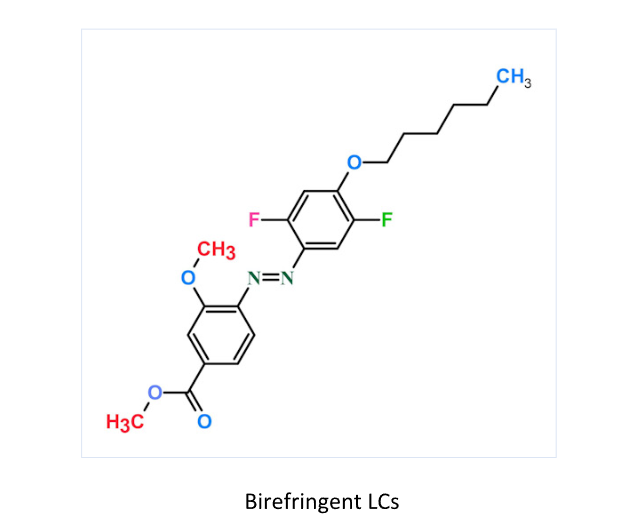

🧬 What Are Birefringent Liquid Crystals?
This visualization depicts a birefringent liquid crystal molecule. Its elongated, rigid structure and specific chemical groups create an anisotropic molecular arrangement—meaning its properties differ depending on the direction of measurement. This anisotropy is the fundamental source of birefringence, a unique optical property that makes these materials indispensable in modern technology.
🔍 How Birefringence Works
Birefringence allows a liquid crystal to split a light ray into two components that travel at different speeds. By applying an electric field, we can precisely control the orientation of these molecules, and thus, manipulate the polarization of light passing through them. This principle is the very foundation of Liquid Crystal Display (LCD) technology.
⚙️ Molecular Structure & Key Features
Anisotropic Core: A rigid backbone of aromatic rings provides the shape and polarizability needed for birefringence.
Tailored Functional Groups: Ester linkages and fluoro-substitutions enhance molecular stability, optimize optical performance, and improve alignment in electric fields.
Flexible Alkyl Chains: The terminal chains influence the temperature range and stability of the liquid crystal phases.
🖥️ Key Applications & Technologies
Birefringent LCs are the engine behind a wide range of technologies:
High-Performance Displays: LCDs for televisions, monitors, and smartphones.
Advanced Optical Devices: Tunable filters, optical modulators, and phase retarders.
Next-Generation Photonics: Components for augmented reality (AR)/virtual reality (VR) systems and adaptive optics.
🚀 Future Research & Development
The evolution of birefringent liquid crystals continues to drive innovation. Current research focuses on:
Developing new LC mixtures for faster response times and higher resolution in displays.
Creating materials for flexible and stretchable electronics.
Engineering tunable birefringent systems for smart windows and reconfigurable optics.